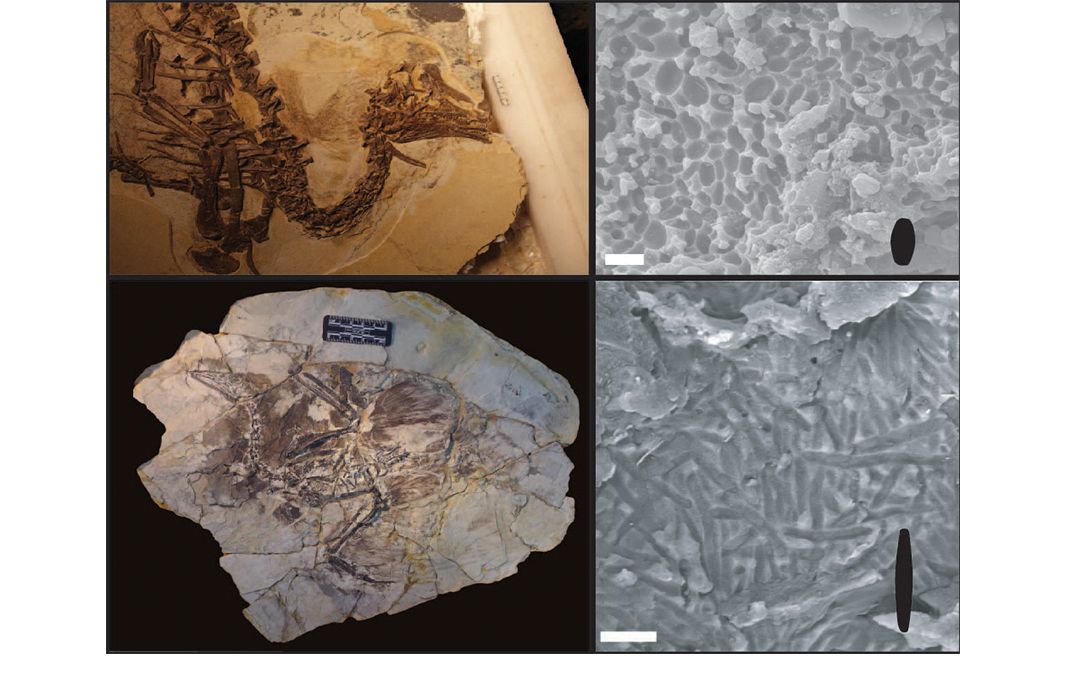Colorful Plumage Began With Feathered Dinosaurs
The pigment patterns scientists use to predict ancient animal colors started with feathered dinosaurs and led to vibrant color in birds
/https://tf-cmsv2-smithsonianmag-media.s3.amazonaws.com/filer/5d/40/5d40f5a7-5ac6-405a-ab11-81937bb9dad5/1280px-caudipteryx_zoui_-_untere_kreide_-_liaoning-china.jpg)
What color were the dinosaurs? Museums, movies, and paintings give us a vibrant picture of giant lizards in bright greens, yellows, purples, and blues. But, the truth is, dinosaur color is a bit of a mystery. Paleontologists like Julia Clarke of the University of Texas in Austin and others are trying to solve this mystery using the one of the most common natural color pigments in the world: melanin.
In a recent study in Nature, Clarke and her colleagues suggest that feathered dinosaurs injected a range of color—at least color that comes from melanin—into the ancient world. Researchers think that the appearance of this color variety in dino plumage was a side effect of a change in the way the ancient animals stored and used energy. The findings have implications for how paleontologists reconstruct what these and other dinosaurs looked like.
Melanin is responsible for darker skin coloration in humans, darker spots or stripes in lizards, and darker feather colors in birds. Tiny packages within our cells called melanosomes house melanin. In humans and birds, the shape of these melanosomes corresponds to different chemical forms of melanin and thus, different colors. For example, red hues come from round melanosomes, and gray hues come from long and skinny melanosomes. Melanosomes come in a wide variety of shapes and sizes, and those correspond to a wider variety of colors.
The multishaped melanosomes found in birds led scientists—particularly paleontologists—to wonder whether similar melanosomes are found in ancient birds and feathered dinosaurs, the ancestors of modern birds. Luckily, some fossil finds include fossilized feathers, and, with a high-powered microscope, scientists can actually see melanosome structures preserved in these petrified plumages.
Without a modern specimen to compare fossils to, scientists use the shapes of melanosomes in modern birds to give hints on what colors a particular feathered dinosaur or extinct bird might have sported. “This is like a toolkit for us,” explains Clark. Using this technique, Clarke and colleagues at the University of Akron in Ohio and China's University of Geosciences have linked the shapes of melanosomes in fossils to red, gray, black, or iridescent hues in ancient fossilized birds and feathered dinosaurs.
But Clarke's team knew that fossilized melanosomes had more to reveal. Scientists hadn't looked at melanin color in anything beyond a few mammals, birds, and feathered dinos, the researchers wanted to see if melanosome shapes across the spectrum of the animal kingdom, extinct and living, could shed light on when the pigment packets' shapes evolved to exhibit such variety. Pinpointing this timing would give them strong evidence for when dinosaurs evolved different colors.

The team started off by sampling hair, skin, and feathers from 181 living mammals, turtles, lizards, crocodiles, and birds. In China, they examined fossils from 13 lizards, turtles, dinosaurs, and flying reptiles called pterosaurs, all from from the Cretaceous and Jurassic periods, about 200 to 66 million years ago. The fossilized samples ranged from preserved feathers to patches of skin to fuzzy filaments from animals that sported spikes that were not quite feathers.
The reasearchers then used a scanning electron microscope to visualize the melanosomes in these ancient structures. They looked at what type of body covering the melanosomes from each sample (extinct and living) came from—skin, hair, fuzz, or feathers—and measured differences in their shapes across different animal lineages: bird, mammal, and reptile.
“If you look at living lizards, turtles, and crocs there’s a very small range in melanosome shapes,” says Clarke. “You might have very similar, only very subtly different shaped melanosomes in a brown versus a black versus a grey toned lizard.” And, not much had changed in from ancient turtles and lizards to modern ones—the menalosomes in fossilized lizard and turtle remains also look too much alike and can’t be used to predict what color the animals might have been.
However, feathered dinosaurs, specifically the first maniraptor dinosaurs which showed up on Earth about 150 million years ago and ultimately became birds, sported the greatest diversity of melanosome shapes. Interestingly, fuzzy dinosaurs—those with spiky filaments and protofeathers—evolutionarily preceded their feathered brethren, but they don’t show melanosome shape diversity either. “Only with the origin of feathers do you then see a huge explosion in diversity of melanosome shapes,” says Clarke.
An explosion in melanin color diversity likely came with this range in melanosome shape. That doesn't mean that ancient lizards, turtles, and dinosaurs with scales or just filaments weren't colorful. They may have simply relied on different pigments for their color, Clark explains.
Weirdly, mammal hair and modern bird feathers share this diversity in melanosome shape, despite the fact that they are totally unrelated animal families. On a molecular level, mammals and birds even make melanin-based colors in totally different ways. Nevertheless, it appears that they each independently evolved this melanosome diversity.
But, why would melanosomes evolve different shapes in feathered dinosaurs and not earlier? Clarke and colleages suggest that, in feathered dinosaurs at least, the variety of melanosome shapes may have something to do with the creatures' physiology. For clues on what that something may be, Clarke draws again on the ancestral relationship between feathered dinosaurs and birds.
Scientist have observed a genetic connection between how melanosomes are made and how birds regulate energy—in particular, some genes that determine melanosomes shape are also involved in fat storage in chickens. Based on this, the researchers think that a genetic change related how feathered dinosaurs regulated energy in their bodies could have inadvertantly caused a shift in how they made melanin.
If true, this would be a good example of pleiotropy, where one gene set can influence seemingly unrelated traits, a phenomenon that's pretty common in the biological world. For now, though, we're one step closer to understanding the rules that govern a dinosaur's complextion.
/https://tf-cmsv2-smithsonianmag-media.s3.amazonaws.com/accounts/headshot/Screen_Shot_2014-01-27_at_12.05.16_PM.png)
/https://tf-cmsv2-smithsonianmag-media.s3.amazonaws.com/accounts/headshot/Screen_Shot_2014-01-27_at_12.05.16_PM.png)